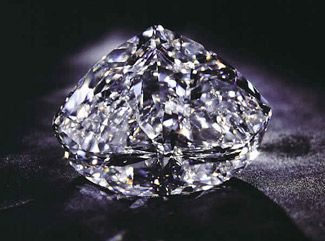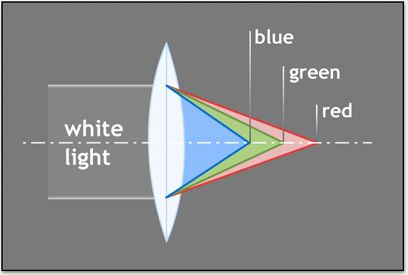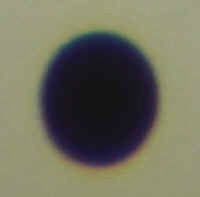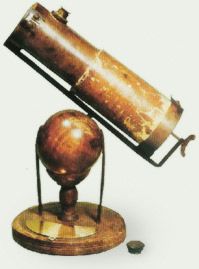Dispersive refraction effects in crystals
Crystals have their own colors (see emeralds and rubies), but dispersive refraction can enhance the appeal of a well-cut jewel.

In a well-faceted gemstone, a ray of light passing into the
top of the stone undergoes total internal reflection and is returned to
the eye as the "brilliance." Light reflected back towards the observer
will be dispersed by refraction if the gemstone has a high refractive
index.
|

Since the geometry of the path corresponds to that in a prism,
the reflected rays are also refracted, leading to flashes of color, or
the "fire" in a stone. The amount of fire depends on the magnitude of
the dispersion. The diamond has a very high dispersion, the highest of
any naturally occurring gemstone, as well as a very high refractive
index.
|

More complex effects occur in crystals that have a different
refractive index for different optical planes. The crystal on the right
is anisotropic and creates a double image, as compared to the isotropic
left-hand crystal.
|
|
Getting rid of dispersive refraction: chromatic aberration
Light is dispersed into the colors of the spectrum by refraction. When we are using a refractive lens to enlarge an image, this becomes a problem; we don’t want to see the image with distorted colors at the edges of objects. This problem is known as chromatic aberration.Chromatic aberration is a problem for any devices relying on lenses, such as telescopes, microscopes, and cameras. Digital cameras include software to compensate for this effect.
The magnifying lenses of early telescopes were simple convex lenses. At high magnification, refraction by these lenses dispersed the light into its component colors, haloing the stars and planets in rainbow colors and distorting the image seen.
Newton was the first to solve this problem, enlarging the image by reflection instead of refraction.

In addition to creating extra colors, dispersive refraction creates different focal lengths for different colors, so that edges in the projected image are blurred.
|
|

An image of Venus with a colored rim caused by chromatic aberration
|

This photograph shows uncorrected chromatic aberration. The window edges are blurred and colored.
|

This is the design of telescope Newton developed to overcome
the chromatic aberration inherent in earlier refracting telescope
designs. Note that the eyepiece is on the side of the telescope, not at
the lower end as in the telescopes we use today.
|

Various geometries of reflecting telescopes
|
There are applications that still use a refracting lens, so other methods of reducing chromatic aberration are employed. One method uses lenses of glass with different refractive indices. Joining a flint glass negative lens, which has a higher refractive index, to a crown glass positive lens, with a lower refractive index, forms a doublet lens corrected for dispersive refraction haloes.
No comments:
Post a Comment